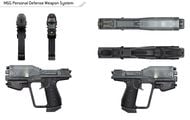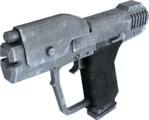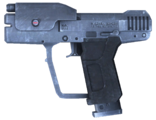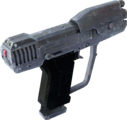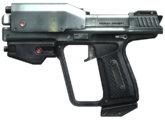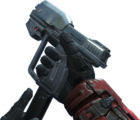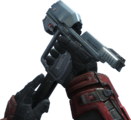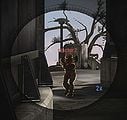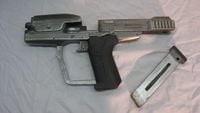M6G magnum
From Halopedia, the Halo wiki
Template:Weapon Infobox The M6G Personal Defense Weapon System (PDWS) is a handgun in Misriah Armory's M6 series. It is commonly used as a sidearm by UNSC Defense Force personnel.[1]
Specifications
Design details
The M6G PDWS is a semi-automatic, recoil-operated, magazine-fed, large-caliber handgun. It is a later model of the M6 series sidearms that was distributed to officers and vehicle/weapon crews.[1] The weapon has a polymer handle, along with a titanium alloy body and a nickel-plate finish. The sidearm fires the M225 SAP-HE (Semi-Armor Piercing, High Explosive) rounds from an 8-round magazine at a velocity of 427 m/sec (1302.35 ft/sec). In addition, the weapon is issued with a KFA-2 x2 optical, smart-linked scope.
The weapon's performance seems tied to its year of manufacture.[note 1] Whereas the 2548 model used by the UNSC Army has a rate of fire of 240 rounds per minute (4 rounds per second), the 2552 model used by the UNSC Marine Corps fires at a rate of only 120 rounds per minute (2 per second). In either case, with a maximum effective range of 50 meters, superb accuracy, and high stopping power, the M6G proves very useful during scenarios where primary arms are not available.
Ammunition
- Main article: M225 SAP-HE
The M6G uses 12.7x40mm M225 SAP-HE (Semi-Armor Piercing, High Explosive) .50 caliber ammunition loads. These rounds have a jacket of copper or cupro-nickel around the projectile while the projectile itself is hollow and filled with an explosive compound and a delayed-detonation impact fuse. When the round impacts a target, the jacket will initially help the projectile maintain its shape, allowing it to travel into the target before detonating almost immediately after impact, causing massive tissue damage and system shock. Probable reasons for using semi-armor piercing rounds instead of armor piercing projectiles are both to prevent over-penetration of hostiles and decreasing the risk of friendly fire during CQB and urban combat, and their devastating efficacy against soft targets. The explosive properties of the rounds render them decently effective against personal shielding systems and are also capable of damaging lightly-armored vehicles.
Variants
There are at least two variants of the M6G, itself only one of several models in the M6 series. These variants, which bear notable differences in function and superficial design, can be distinguished by their year of manufacture.[note 1]
2548 model
This model was issued to UNSC Army troopers on Reach during the Covenant's invasion in the summer of 2552. It has a rate of fire of approximately 240 rounds per minute (4 rounds per second), though its accuracy suffers slightly as a result. The slide is tapered at the rear and sports forward-facing, diagonal serrations. The magazine release is set above and parallel to the lower lip of the trigger; the magazine's lip is shaped like an irregular trapezoid. The striker juts farther from the slide, reminiscent of a hammer. This model is equipped with an underslung flashlight attachment or laser module.
2552 model
This model was used by UNSC Marines stationed on Earth during the fall of 2552. It sports the same general design and proportions as the aforementioned version, despite a subtly longer barrel. While its rate of fire is only half that of its predecessor, (roughly 120 rounds per minute), its accuracy is superior.[1] The smart-linked scope's mounting pins are closer to the muzzle. The slide has vertical serrations and a flat rear. The magazine release is set just in front of the safety switch and has a thin, rectangular lip akin to earlier M6 models. The striker is recessed into the slide as on a 21st century Glock.
Gameplay
Changes between games
Changes from Halo 3 to Halo: Reach
- The smart-linked scope is now usable.
- Has reticule bloom, like most weapons in Halo: Reach.
- Nearly doubled rate of fire.
- Has a differently designed slide, grip, and magazine.
- Has an unusable flashlight attachment.
- Slightly shorter barrel.
- Different firing sound.
- Different reloading and melee animations that are very similar to those of the M6D from Halo: Combat Evolved, wherein the SPARTAN flips the weapon in the air after striking.
Tactics
Campaign
- The M6G is quite useful against most sparse targets that are encountered throughout diverse combat. Enemies such as Grunts and Jackals can be quickly dispatched with one well-placed shot to the head and enemies like Drones and members of the Flood can be dispatched in as little as 1-2 well-placed shots. The same can be applied to unshielded Brutes with one well-placed shot to the head.
- The M6G's high-caliber rounds give it the ability to stumble non-berserk, unshielded enemies. This is most effective fired at the feet, when enemies like Brutes suffer the longest injury recovery time.
Multiplayer
- Wielding a pair of Magnums performs quite well against shielded targets, but is restricted due to their rate of fire. Dual-wielding a Magnum with other weapons such as an M7/Caseless Submachine Gun or a Plasma Pistol is also quite effective as the SMG depletes shielding quickly, while the Magnum finishes the target off; a Plasma Pistol's charged shot will completely drain any shielding system allowing the Magnum to perform the lethal head shot. In Reach, the faster rate of fire means that it can be used as an effective close quarters weapon as opposed to a back up weapon. Fire at opponents' body to drain their shields and use the remaining shots at their head.
Trivia
- In Halo 3, the stamping on the side of the M6G incorrectly labels it as a Model 6C. In Halo: Reach, it is labeled as a Model 6B, though this was corrected in the M6 series article on Halo Waypoint.[2]
- Similarly, WETA Workshop's M6G prop features the same manufacturer's markings as the Halo 3 model, albeit stenciled instead of engraved. However, the year 2552 is misprinted as 5225.[3]
- Like the M6D, the M6G has Asian calligraphy stamped on the barrel, but in this case, they are Korean Hangul, not Japanese Kanji. It is also featured on the bottom of the magazine. The symbol 일곱 (il-gohb) translates to the number seven.
- It is incorrectly labeled in the Halo 3 instruction manual as holding 12 rounds per magazine, instead of the actual 8.
- In Halo 3, when a full magazine is emptied, the slide of the M6G does not lock back to wait for another fresh magazine to be inserted.
- In Halo: Reach, Spartans wielding M6Gs use a nearly identical melee animation to the M6D pistol in Halo: Combat Evolved. Elites however, use an animation similar to that used by both species in Halo 3.
- The M6G features unusable attachments in both games in which it appears. The scope is unusable in Halo 3 for gameplay balance, while the flashlight is unusable in Halo: Reach due to the introduction of night vision equipment.
- John-117 wields an M6G in the cover art of Halo: Combat Evolved Anniversary in lieu of the M6D, which is featured in the game. The cover art was designed while the M6G's model was being used as a placeholder for the M6D during the development of the game and was not changed when the pistol's in-game model was replaced.
Gallery
- Reach concept-M6G.jpg
Concept art of the M6G for Halo: Reach.
- Magnum Reticle.svg
The reticule of the M6G.
- HaloReach - M6G.png
Right side view of the M6G in Halo: Reach. Note the mislabeling.
- Halo3-MasterChief-DualPistols.png
The Master Chief, John-117, dual-wielding M6G Magnum Pistols in Halo 3.
- M6G Pistol One Handed.jpg
A Marine holding the M6G in Halo 3.
Side view of an M6G Magnum Pistol replica with slide locked back, as seen in Halo: Landfall, created by Weta Workshop.
A locker full of M6G sidearms, fresh from Misriah Armory in Halo: Landfall.

|
Browse more images in this article's gallery page. |
List of appearances
- Halo: Landfall
- Halo: Arms Race (First appearance)
- Halo: Combat
- Halo: Uprising
- Halo 3
- Remember Reach
- Halo: Reach
Note
- ^ a b Due to the considerable differences between Halo 3's M6G and Halo: Reach's M6G, this article assumes that the two incarnations are distinct variants of the weapon. The inability to use the weapon's smart-linked scope in Halo 3 is simply a matter of gameplay balance: the scope is clearly modeled on top of the slide in both games.
